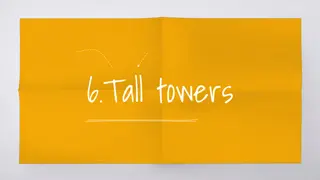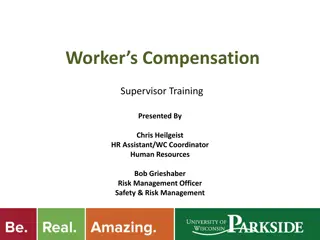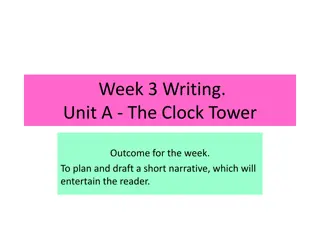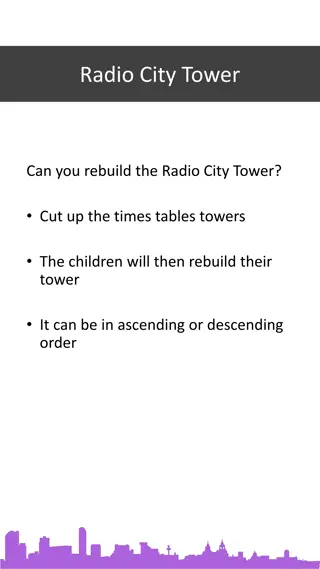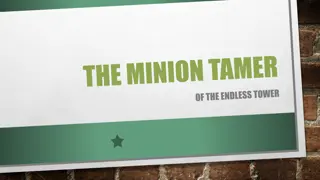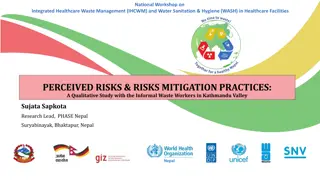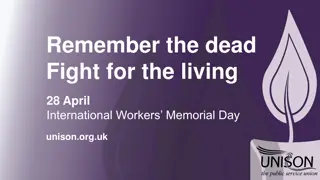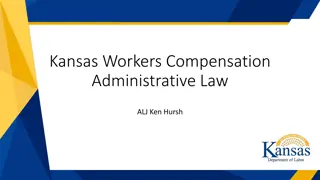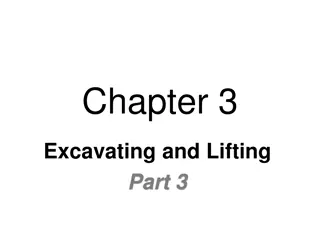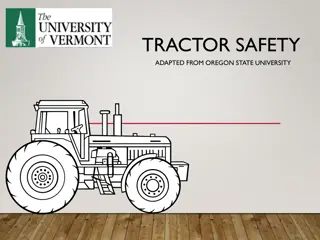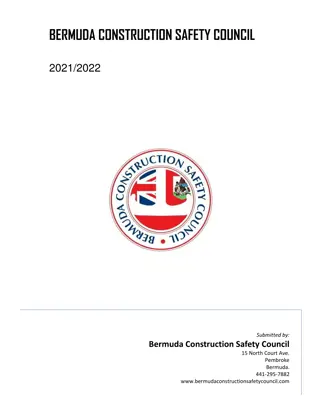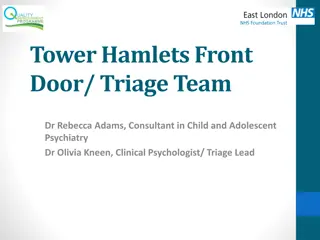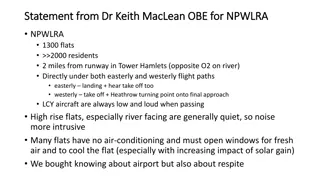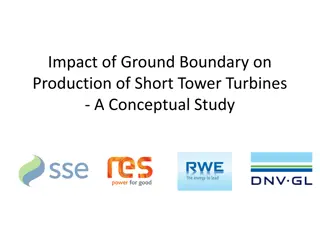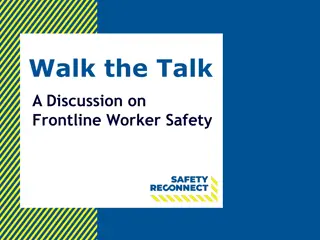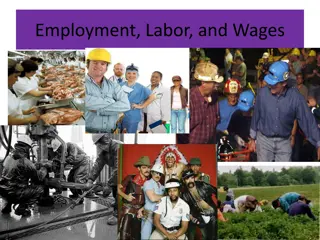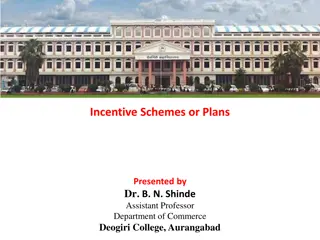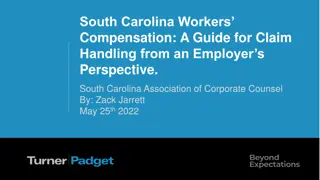Tower Safety Best Practices for Communication Workers
Tower safety is a critical concern for communication workers, especially those dealing with "Big Iron" towers used in broadcasting. This presentation highlights the risks involved, best practices for protection, statistics, and case studies like the Philadelphia incident. It emphasizes important measures such as proper tie-off procedures, training, safety meetings, and OSHA/FCC recommendations for safety and health management systems.
Uploaded on Sep 30, 2024 | 0 Views
Download Presentation

Please find below an Image/Link to download the presentation.
The content on the website is provided AS IS for your information and personal use only. It may not be sold, licensed, or shared on other websites without obtaining consent from the author. Download presentation by click this link. If you encounter any issues during the download, it is possible that the publisher has removed the file from their server.
E N D
Presentation Transcript
Tower Safety Austin, TX August 11, 2016 Sim A. Kolliner CPBE
There is always risk in building and maintaining the "Big Iron" towers we use in broadcasting. However, there are things we can do to protect lives and property.
What is Riding The Load? Tying off to the load rather than the load line The Load Goes, So Go You Don t Ride The Load Tie-off With A Separate Clamp To The Load Line Climb Alongside the Load On The Ladder Ride In A Separate Personnel Lift (If Used)
Philadelphia 11-10-1998
What Could Have Been Done in Philadelphia to Produce a Different Outcome? Tie off to a cable clamp above the load clamp? Climb ladder instead? Training? Safety meeting? 100% tie off commitment?
OSHA & FCC Sharing Best Practices Recognizing the risks that tower workers face, OSHA and the FCC organized a workshop on communication tower worker safety on October 14, 2014. During this workshop, industry stakeholders, along with worker safety advocates and the families of communication tower workers who had been killed on the job, gathered to discuss the issues surrounding tower safety. This presentation contains portions of the OSHA/FCC Best Practices document.
OSHA & FCC Sharing Best Practices Safety and health management systems All entities should establish a comprehensive safety and health management system. Core Elements o Management leadership o Worker participation o Hazard identification and assessment o Hazard prevention and control o Education and Training o System evaluation and improvement o Communication on multiemployer workplaces
OSHA & FCC Sharing Best Practices Tower Climbers and Ground Crew Workers All work crews must be provided with and must use proper safety equipment at all times. All workers should annually certify their commitment to 100 percent tie off. All climbing work should include comprehensive safety planning. All work crews should not work at heights when weather conditions raise safety risks. All work crews should continually seek to enhance their safety skills and awareness through regular trainings and stand-downs. Particular attention should be paid to inspections, including equipment inspections. Contractors must ensure that there is a competent person on site at all times. This person should monitor the mental and physical wellbeing of climbers on their team.
OSHA & FCC Sharing Best Practices Tower Owners Tower inspection and maintenance: Tower owners should ensure that their towers are maintained properly, structural inspections, including TIA-222-G, are conducted on a regular basis and have a properly installed, maintained and functioning safety climb system. Ensure that there is a clear procedure for reporting unsafe conditions on towers and that all reported conditions are tracked until the hazardous conditions have been fixed. Inspections: Hire a company using drones for tower inspection to reduce unnecessary climbing and avoid putting workers at risk. Tower owners are strongly encouraged to require contractors to send photos of completed work to their central command centers. The command centers can then immediately approve the work before the worker even descends the tower. This can reduce unnecessary climbing for re-work.
OSHA & FCC Sharing Best Practices Tower Construction and Maintenance Contractors Safety and health management systems: Contractors should have a written, comprehensive health and safety management system that is implemented on all worksites. Elements of this system should include, at least, training, inspections, audits, personal protective equipment, and individual work practices. Contractors should ensure that all employees are aware of existing consensus standards governing communication tower work and are familiar with the requirements that apply to their work activities. Encourage all employees to report unsafe conditions at work sites to company management, as well as to relevant parties up the contracting chain. When starting work for the day, foremen should conduct a toolbox meeting where the Job Hazard Analysis (JHA) is discussed.
OSHA & FCC Sharing Best Practices Tower Construction and Maintenance Contractors Auditing and incident investigations: Whenever an injury or fatality occurs on a work site, contractors must first notify all appropriate authorities, including local emergency services and OSHA. Contractors should have internal policies for investigating incidents that take place on work sites in order to determine the root cause of the incident. If the incident is due to an individual bad actor, then the contractor should re-examine internal policies for employee training, re-training the individual and all employees if needed.
OSHA & FCC Sharing Best Practices Tower Construction and Maintenance Contractors Work site safety practices: All contractors should require supervisors to conduct a tailgate meeting at the beginning of each work day. Contractors should institute work policies and procedures that guarantee that safe work practices will always be followed on site. Zero-tolerance policy to unsafe work practices: It is quickly becoming a recognized best practice in the industry to institute a zero-tolerance policy regarding unsafe practices, in particular towards free climbing. Sub-contractor vetting: Where further subcontracting is permitted, contractors should take precautions to ensure that any potential sub-contractors have effective safety and health programs in place, and have a history of safe work practices on site.
OSHA & FCC Sharing Best Practices Tower Construction and Maintenance Contractors Recordkeeping and communication: Contractors should keep comprehensive records of all employee training and certifications. Contractors should obtain necessary technical and engineering specifications from tower owners. Training: Contractors should ensure that all employees who climb communication towers are trained for the tasks that they will be expected to perform. Contractors should ensure that employees new to tower climbing undergo comprehensive training as authorized climbers. Employees who will be expected to perform rigging or hoisting activities should have specialized training to ensure that they can safely perform these tasks. Contractors should ensure that employees are re-trained at appropriate intervals, as well as on an as-needed basis.
OSHA & FCC Sharing Best Practices Tower Construction and Maintenance Contractors Training: Contractors should ensure that employees are re-trained at appropriate intervals, as well as on an as-needed basis. When making use of train the trainer programs, ensure that the employee who will be performing training is adequately prepared to train all employees.
OSHA Directive CPL 02-01-056
Appendix A OSHA Directive Compliance Guidelines for Employee Access by Hoist During Communication Tower Work Activities Table of Contents Definitions Hoisting Personnel Training Equipment Trial Lift and Proof Testing Pre-Lift Meeting Documentation Hoisting Employees to or from the Workstation V Communication Between the Hoist Operator and Hoisted Employees VI Falling Object Hazards Weather Conditions Energized Power Lines Hydraulic Hoists (Drum Hoists) Hoist Mounting Drums Brakes and Clutches Hoist Controls Wire Rope and Rigging Hoist Operator Hoist Inspections II II II III IV V V CPL 02-01-056 VII VII VII VII IX IX IX X XI XI XI
Elevator Safety Contractor Safety Plan Training Check and Look Make sure you are disconnected before you go DO NOT bypass any interlock or safety devices. Your Part Make sure the elevator is working properly Checklist Training Certification Authority to Stop Work Pre-Climb Meeting Assure no interlocks are bypassed
FAA Tower Lighting Logging Requirements Light Malfunction Notification Strobes Planes Will Hit What They Can t See
RF Safety Contractor Safety Plan Training Safety Gear Measurement Devices Your Part Observation Checklist Training Certification Safety Gear Authority to Stop Work Pre-Climb Meeting
Things To Remember DO NOT Ride The Load Safety Equipment, check it and use it every time Training, Training, Training (Did I Mention Training) 100% Tie Off Commitment Pre-climb meeting and Job Hazard Analysis (JHA) Anyone should be able to stop work if hazardous Assess and document tower work Have someone observe if possible Ensure RF Exposure Safety
In Summary Common Sense and Awareness MUST Come First! Have a Plan That Documents, Informs and Protects Meet Before Work Starts to Review The Plan Make Sure Climbers are Trained and Current Make Sure Anyone Can Stop an Unsafe Operation Check the Contractor s Safety Record and Reputation Don t Let The Schedule Determine Safety Ask for Verification of Training and Vet the Subcontractors too AND FINALLY .
Remember - OSHA is NOT a City in Wisconsin !



